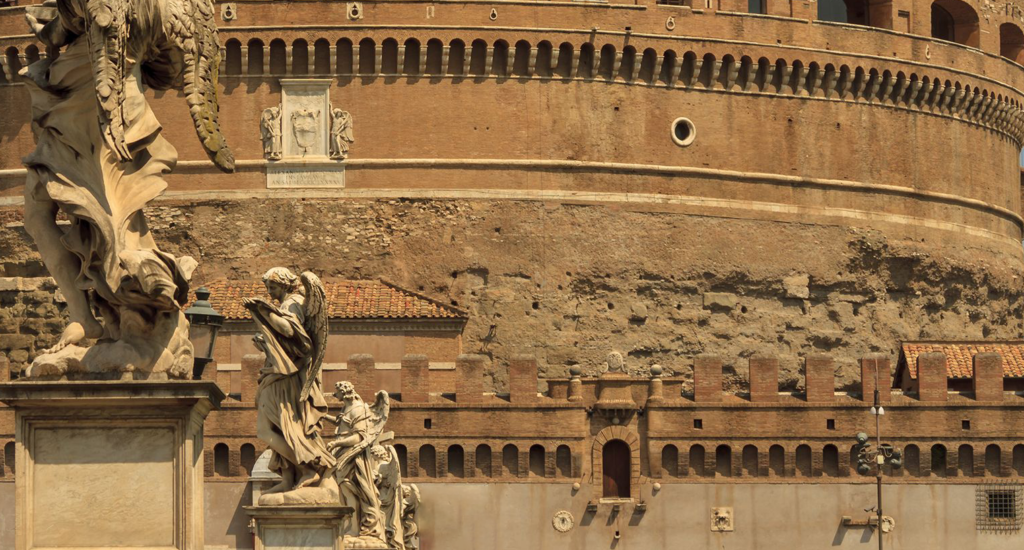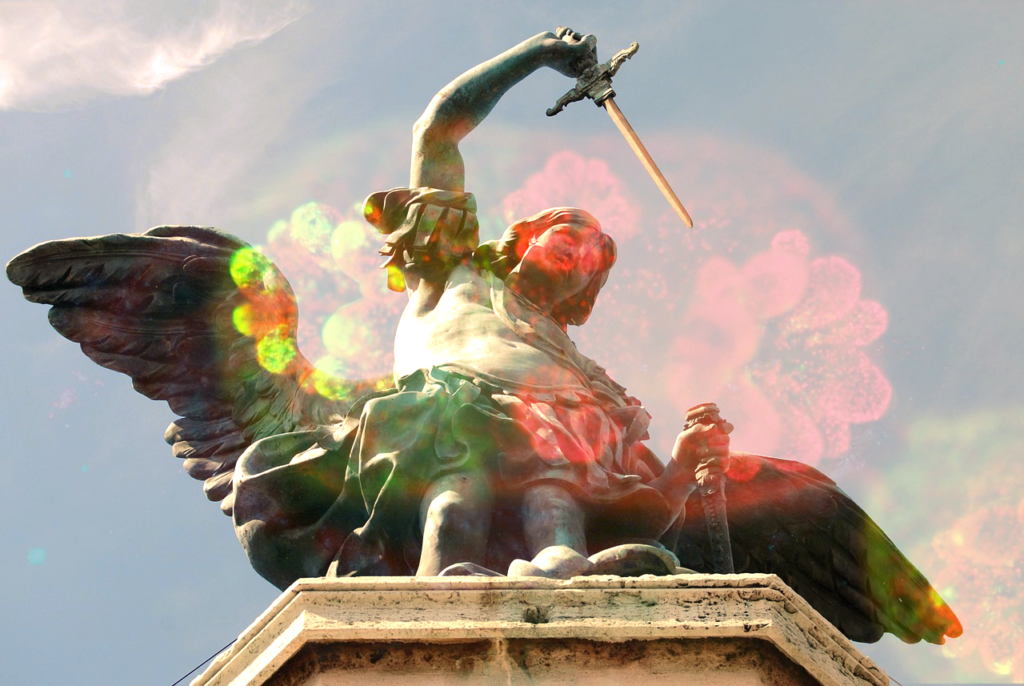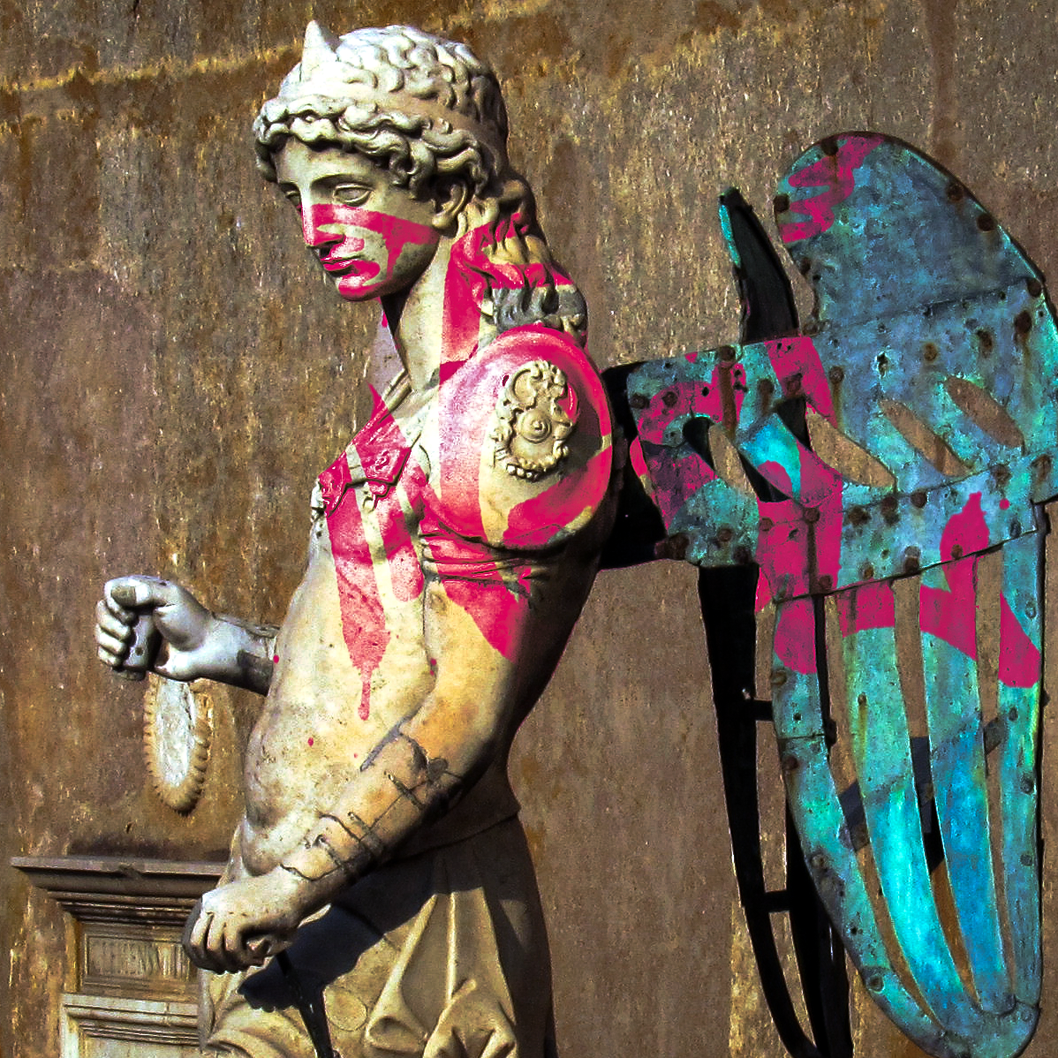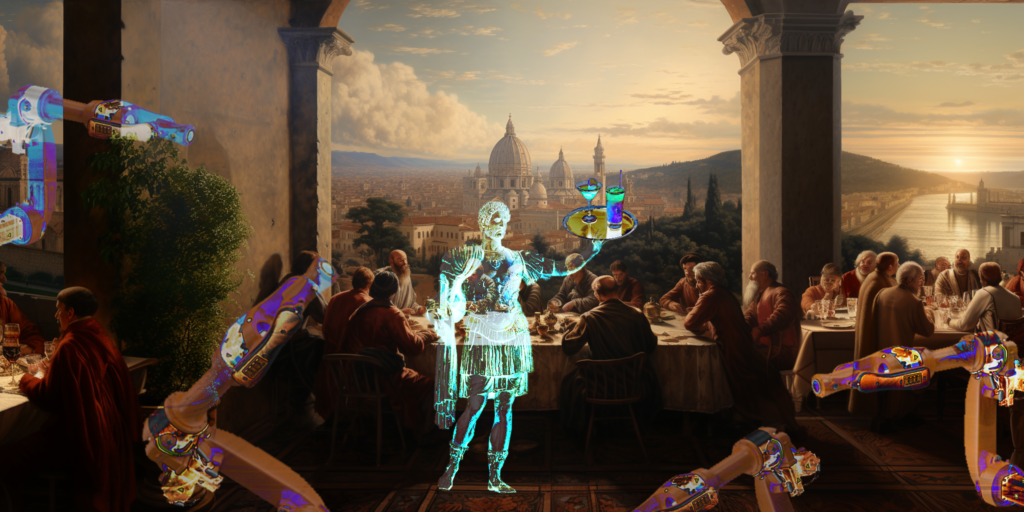With multiple intelligences informing design, does the notion of the Author in Architecture become obsolete?

ACT I
Of Pen and Brick

Fig 1. Castel Sant’Angelo from Il Ponte Sant’Angelo
A towering fortress, a sentinel of time, that has borne witness to the rise and fall of emperors, astounding works of art, the whims of popes, and the drama of epic battles; its authorship blurred by a variation in contributing entities – Castel Sant’Angelo.(Fig 1)
It is alongside a seemingly insignificant clerestory puncturing the fortified walls, where our story begins.
Tour Guide: Now this one is special… Between me and you, I’m not supposed to go off-script – but this part of the guided tour always gets to me.
Vehemently gesturing, stifling a sniffle with his right hand
Il Ponte Sant’Angelo, almost 1,900 years old, is one of just two ancient Roman Tiber River bridges that still survive today. Observe the beauty in her soundness, a divine vision which, for some people centuries ago, was a symbol of the end of bad times and the coming of glory.
Owen: Amazing!! These ancient structures’ enduring stability owe much to the skill of the architects of antiquity!
The group continue their journey on the spiral ascent inside the castle, their voices echoing off the thick chiseled bricks of the interior, getting lost in the darkness of the ceiling where the candlelight cannot reach.
Geppetta: The brickwork of this place speaks marvels of its time and the people’s accomplishments. It is the bricks that tell more of the story and the history than any design.
Owen: It is not true Geppetta, “the Author is thought to nourish the book, which is to say that he exists before it, thinks, suffers, lives for it, is in the same relation of antecedence to his work as a father to his child.”(1) This building is the descendant of the mind of the architect, as it has been created and born through his mind.
Geppetta: Well, “the only work truly made by the author is the design of the building-not the building itself, which by definition is made by others. The only way for [your beloved] Alberti to claim an extension of authorship, so to speak, from the drawing to the building was to require that the building and its design should be seen as perfectly identical” (2)
She turns her hands in triumph to a withering brick wall. The group stops their ascent to look at a room that still holds its head with the air of importance, but sighs with its age. Cracks showing and paint chipping off a small column clinging to life.
She continues,
Which as you can see here, is not identical to the design at all. Withered and old. Therefore it is not the design that has stood the test of time, but the mastery of the builders and the quality of the stone.
Owen: Crazy! Do you know how many sleepless nights an architect needs for such a perfect idea?
Tour Guide: Ah! A debate breaks out I hear…
Matthew: Ragazzi, it does not matter. You may argue about this for hours but even, “Darwin and his modern successors have shown very convincingly how inherited variations are naturally selected, but they leave unanswered how variant organisms came to be in the first place” (3)
Owen: “The author still reigns”(4) in my opinion.

Fig 3. The archangel Michael perched on top of Castel Sant’Angelo
Tour Guide: Si, but each of your approaches are very singular, as opposed to the idea of collective authorship, the idea that “the tree of life is a twisted, tangled, pulsing entity with roots and branches meeting underground and in midair to form eccentric new fruits and hybrids…”(5)
Geppetta: I can almost see the archangel up ahead everyone!
Tour Guide: Andiamo!! Guys we must keep moving, we have much to see!
ACT II
He Who Sprayed It Made It

Fig 4. The tainted statue of the archangel Michael in the courtyard of the wells, Castel Sant’Angelo
The group attempts to move further along the ramp but is abruptly interrupted by screams from outside. A large harsh SHRIEK is heard followed by faces of worry. The group quickly scurries, twisting up the ramp in concern, confronted by the striking visual of the hybrid archangel covered in graffiti.
Matthew: Oh, this is something I can support. Until now, I must say this place has been quite ‘mediocre.’ It would all be improved with a touch of ‘modernity,’ and lo and behold, here we have some.
They all look at Matthew in disgust.
Owen: Modernity!? No, this building is that of the ancients. That is not how their designers or architects intended it.
Matthew: But Owen, you see, “our outlooks shape what we see and what we know. Any idea we conceive as fact or truth is integrated into an entire style of thought, of which we are usually unaware. Call the cultural constraints ‘trained incapacities,’ ‘thought collectives,’ ‘social constructions of reality.’ Call the dominating inhibitions that determine our point of view whatever you wish. They affect all of us.”(6)
Owen: Dio mio, thank Sant’Angelo my grandfather is not here to see this
Matthew: You mentioned earlier he was a sculptor, right?
Geppetta: Third generation marble sculptor, si.
Matthew: Well, a maker “can only imitate a gesture that is always anterior, never original.”(7)
Geppetta: What are you implying?
Matthew: “It’s very important for [designers] to think of how the community created by a [design] is engaged in its ongoing transformation – [like] bodily experiences by users.”(8)
Maybe your grandfather would be amused by the graffiti on the statue – find it refreshing even, “an authorship shared between architects and users”, (9) no?
Owen: The way I see it, “classic criticism has never paid any attention to the reader; for it, the writer is the only person in literature”(10)
Matthew: You know, there’s a saying that goes, “a whale’s worth more dead than alive.” In a museum, the fragmented statue attracts more tourists than those pristine outside. After all, it’s the packaging that determines the value, isn’t it?
Tour Guide: Mamma Mia! No no… These both can be true! “Symbiogenesis brings together unlike individuals to make large, more complex entities.” “Now and throughout Earth’s history, symbiosis, both stable and ephemeral, have prevailed.”(11)
It is all that creates one. We can see this here from the layering of time within this structure. “Individual parts alone do not constitute architecture; architecture emerges when the parts are assembled into a single organism.” (12) This is what makes it so magnificent!
Geppetta: Hmmm… I actually don’t know what my grandfather would think right now…
Owen: Drinks at the bar? I could use some fresher air after seeing this poor desecrated angel.
Geppetta: Me too!
Matthew: Me three!
Tour Guide: Follow me! Tiddely Poms for everyone on me.
Matthew, Geppetta, & Owen: Tiddely Poms?
ACT III
Schrödinger’s Author

Fig 6. Ciboteca de Angelo
The group have reached the final stairs leading to the RomAIn Bar Resto. A peculiar sound washes the stairway; that of drunken chatter, cloaked by mechanical churning.
Matthew: I don’t recall reading about this place in the brochure… What a stark contrast to the building itself.
Tour Guide: Si, they renovated my favorite restaurant a couple of months ago. Everything you see here is designed and run by artificial intelligence. Impressive no?
As they approach, a service bot gently slides out of the entrance and welcomes them.
AI Bot – Hadr.AI.n: Buongiorno ladies and gentlemen, welcome to “Ciboteca de Angelo”.
Owen: Emperor Hadrian?? Alive?
Geppetta: And bartending?
AI Bot – Hadr.AI.n: It is true, Emperor Hadrian lives through me. I’ve been trained with every living treatise and decree of his to embody him in the most authentic form. I am also a self-taught mixologist through machine learning. Try my latest Tiddely Pom?
Tour Guide: Raising four fingers at HADR.AI.N
I know this can be overwhelming at first, we’re still testing him out. As we merged Hadrian with AI, we may have lost “what we in retrospect recognize as his former individuality. But, symbiosis generates novelty,” (13) and is novelty not exciting?
Owen: I wonder what Hadrian would think of this
AI Bot – Hadr.AI.n: “The cell remembers; the information of life is intrinsic to its cellular structure. It respects without distracting, without dissolving the environment; integrates itself harmoniously into it.”(14)
Matthew: I think, like the Graffiti, he would appreciate this moment of innovation, the idea that the seed he planted for this building has grown beyond what he had initially imagined, that authorship itself is obsolete! After all, “to give a text an Author is to impose a limit on that text, to furnish it with a final signified, to close the writing.” (15)
AI Bot – Hadr.AI.n: Indeed. “The question is not who is the author? but who creates the creator?” (16)
Tour Guide: Oh yeah, this one taught itself philosophical questioning…
Geppetta: Might as well just ask “what difference does it make who is speaking” (17)
AI Bot – Hadr.AI.n: In defense of myself, “AI could be used as a tool to support, not replace, the creativity and expertise of architects and designers. Using AI to find a design solution does not stop the design process; by all means it just begins; it is like having an active and responsive precedent suggestion tool.”(18)
Owen: So in a sense, “the architect is upgraded to a software designer, thus, regaining the control of these processes through a different role”…(19)
AI Bot – Hadr.AI.n: Right. “The intuition of the designer still maintains relevance in an autonomous system, with both creative agency of the designer and the autonomous system complementing each other in a collaborative framework.” (20) When I – Hadrian – conceived of this place nearly two centuries ago, I alone could never have the capacity to materialize it. I am glad I am reborn two centuries later with the presence of multiple intelligences in my aide.
Tour Guide: “The outcome is as much the artist as the algorithm.” You lot are “the link between all the different pieces of information… everyone is important, but contributes something different.”(21)
Geppetta: But “even when an individual has been accepted as an author, we must still ask whether everything that he wrote, said, or left behind is part of his work.”(22)
Matthew: It seems, Geppetta, that “authorship can no longer account for a linear development which has a ‘beginning’ and an ‘end’… or account for invention and form.” (23)
AI BOT HADR.AI.N clears out the drinks off the table and projects a barcode in the center of the now hunched over and huddled-up group
Owen: Scans the barcode and reads off of his phone
“Leave a review of the tour. Tell us what you think!”
Geppetta: “Please type below your favorite element of the castle”
Matthew: Without a doubt…the Graffiti.
Tour Guide: Letting out a deep sigh and raising a finger at AI HADR.AI.N
Mamma mia… Keep the Tiddelys coming
FIN
Original Post: https://readymag.com/u4249800252/4450645/
(1) Barthes, R, The Death of the Author, 1977
(2) Carpo, Mario, The alphabet and the algorithm, 2011.
(3) Lynn Margulis , Symbiotic Planet, 1998.
(4) Barthes, R, The Death of the Author, 1977.
(5) Lynn Margulis , Symbiotic Planet, 1998.
(6) Lynn Margulis , Symbiotic Planet, 1998.
(7) Barthes, R, The Death of the Author, 1977.
(8) David Adjaye, Nikolaus Hirsch, and Jorge Otero-Pailos in Conversation, “On Architecture and Authorship,” Places Journal, October 2011.
(9) Architectural Authorship in ‘The Last Mile.’” Prospectives, 29 Apr. 2022
(10) Lynn Margulis , Symbiotic Planet, 1998.
(11) Mutualism in Architecture_ An Architecture of the In-Between
(12) Lynn Margulis , Symbiotic Planet, 1998.
(13) Workman, Vivian Ann, “Mutualism in Architecture: An Architecture of the In-Between. ” Master’s Thesis, University of Tennessee, https://trace.tennessee.edu/utk_gradthes/2253 2004.
(14) Workman, Vivian Ann, “Mutualism in Architecture: An Architecture of the In-Between. ” Master’s Thesis, University of Tennessee, https://trace.tennessee.edu/utk_gradthes/2253 2004.
(15) Barthes, R, The Death of the Author, 1977.
(16) David Adjaye, Nikolaus Hirsch, and Jorge Otero-Pailos in Conversation, “On Architecture and Authorship,” Places Journal, October 2011.
(17) Foucault, Michel. “What Is an Author?” Aesthetics, Method, and Epistemology, edited by James D. Faubion and Paul Rabinow, 1998.
(18) Ochoa, Karla Saldaña. “Can AI Mark the next Architectural Revolution?” Medium, Urban AI, medium.com/urban-ai/can-ai-mark-the-next-architectural-revolution-c738339a5f4. 15 Feb. 2023.
(19) Theodoropoulou, Athina. “Architectural Authorship in Generative Design.” The Bartlett School of Graduate Studies, University College London, 2007.
(20) Arief Bin Nik Ab Rahman, Nik. “Authorship: Role of the Architect in Emergent Design.” Academia.Edu, www.academia.edu/9648560/Authorship_Role_of_the_Architect_in_Emergent_Design, 2014.
(21) Peter Eisenman “Post-Functionalism” Oppositions 6, 1976.
(22) Foucault, Michel. “What Is an Author?” Aesthetics, Method, and Epistemology, edited by James D. Faubion and Paul Rabinow, 1998.
(23) David Adjaye, Nikolaus Hirsch, and Jorge Otero-Pailos in Conversation, “On Architecture and Authorship,” Places Journal, October 2011.
Bibliography
– Arief Bin Nik Ab Rahman, Nik. “Authorship: Role of the Architect in Emergent Design.” Academia.Edu, 6 Dec. 2014, www.academia.edu/9648560/Authorship_Role_of_the_Architect_in_Emergent_Design.
-Barthes, R, The Death of the Author, 1977.
-Carpo, Mario,The alphabet and the algorithm,2011.
-Chen, Yixuan. “Architectural Authorship in ‘The Last Mile.’” Prospectives, 29 Apr. 2022, journal.b-pro.org/article/architectural-authorship-in-the-last-mile/.
-David Adjaye, Nikolaus Hirsch, and Jorge Otero-Pailos in Conversation, “On Architecture and Authorship,” Places Journal, October 2011. Accessed 19 Oct 2023
-Foucault, Michel. “What Is an Author?” Aesthetics, Method, and Epistemology, edited by James D. Faubion and Paul Rabinow, translated by Robert Hurley, New Press, New York, New York, 1998, pp. 205–222.
-Lynn Margulis , Symbiotic Planet, 1998.
– Ochoa, Karla Saldaña. “Can AI Mark the next Architectural Revolution?” Medium, Urban AI, 15 Feb. 2023, medium.com/urban-ai/can-ai-mark-the-next-architectural-revolution-c738339a5f4.
-Peter Eisenman “Post-Functionalism” Oppositions 6, (1976)
– Theodoropoulou, Athina. “Architectural Authorship in Generative Design.” The Bartlett School of Graduate Studies, University College London, 2007.
– Workman, Vivian Ann, “Mutualism in Architecture: An Architecture of the In-Between. ” Master’s Thesis, University of Tennessee, 2004. https://trace.tennessee.edu/utk_gradthes/2253

